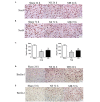Methylene blue exerts a neuroprotective effect against traumatic brain injury by promoting autophagy and inhibiting microglial activation
- PMID: 26572258
- PMCID: PMC4686104
- DOI: 10.3892/mmr.2015.4551
Methylene blue exerts a neuroprotective effect against traumatic brain injury by promoting autophagy and inhibiting microglial activation
Abstract
Traumatic brain injury (TBI) leads to permanent neurological impairment, and methylene blue (MB) exerts central nervous system neuroprotective effects. However, only one previous study has investigated the effectiveness of MB in a controlled cortical impact injury model of TBI. In addition, the specific mechanisms underlying the effect of MB against TBI remain to be elucidated. Therefore, the present study investigated the neuroprotective effect of MB on TBI and the possible mechanisms involved. In a mouse model of TBI, the animals were randomly divided into sham, vehicle (normal saline) or MB groups. The treatment time‑points were 24 and 72 h (acute phase of TBI), and 14 days (chronic phase of TBI) post‑TBI. The brain water content (BWC), and levels of neuronal death, and autophagy were determined during the acute phase, and neurological deficit, injury volume and microglial activation were assessed at all time‑points. The injured hemisphere BWC was significantly increased 24 h post‑TBI, and this was attenuated following treatment with MB. There was a significantly higher number of surviving neurons in the MB group, compared with the Vehicle group at 24 and 72 h post‑TBI. In the acute phase, the MB‑treated animals exhibited significantly upregulated expression of Beclin 1 and increased LC3‑II to LC3‑I ratios, compared with the vehicle group, indicating an increased rate of autophagy. Neurological functional deficits, measured using the modified neurological severity score, were significantly lower in the acute phase in the MB‑treated animals and cerebral lesion volumes in the MB‑treated animals were significantly lower, compared with the other groups at all time‑points. Microglia were activated 24 h after TBI, peaked at 72 h and persisted until 14 days after TBI. Although the number of Iba‑1‑positive cells in the vehicle and MB groups 24 h post‑TBI were not significantly different, marked microglial inhibition was observed in the MB group 72 h and 14 days after ‑TBI. These results indicated that MB exerts a neuroprotective effect by increasing autophagy, decreasing brain edema and inhibiting microglial activation.
Figures




Similar articles
-
Reduction of inflammatory responses by L-serine treatment leads to neuroprotection in mice after traumatic brain injury.Neuropharmacology. 2015 Aug;95:1-11. doi: 10.1016/j.neuropharm.2015.02.026. Epub 2015 Mar 5. Neuropharmacology. 2015. PMID: 25747604
-
Rosiglitazone exerts neuroprotective effects via the suppression of neuronal autophagy and apoptosis in the cortex following traumatic brain injury.Mol Med Rep. 2015 Nov;12(5):6591-7. doi: 10.3892/mmr.2015.4292. Epub 2015 Sep 7. Mol Med Rep. 2015. PMID: 26351751 Free PMC article.
-
Methylene blue attenuates traumatic brain injury-associated neuroinflammation and acute depressive-like behavior in mice.J Neurotrauma. 2015 Jan 15;32(2):127-38. doi: 10.1089/neu.2014.3514. Epub 2014 Nov 13. J Neurotrauma. 2015. PMID: 25070744 Free PMC article.
-
Microglial activation as a compelling target for treating acute traumatic brain injury.Curr Med Chem. 2015;22(6):759-70. doi: 10.2174/0929867321666141106124657. Curr Med Chem. 2015. PMID: 25386818 Review.
-
Neuroprotective profile of enoxaparin, a low molecular weight heparin, in in vivo models of cerebral ischemia or traumatic brain injury in rats: a review.CNS Drug Rev. 2002 Spring;8(1):1-30. doi: 10.1111/j.1527-3458.2002.tb00213.x. CNS Drug Rev. 2002. PMID: 12070524 Free PMC article. Review.
Cited by
-
Autophagy in acute brain injury.Nat Rev Neurosci. 2016 Aug;17(8):467-84. doi: 10.1038/nrn.2016.51. Epub 2016 Jun 3. Nat Rev Neurosci. 2016. PMID: 27256553 Review.
-
Attenuation of Acute Intracerebral Hemorrhage-Induced Microglial Activation and Neuronal Death Mediated by the Blockade of Metabotropic Glutamate Receptor 5 In Vivo.Neurochem Res. 2020 May;45(5):1230-1243. doi: 10.1007/s11064-020-03006-1. Epub 2020 Mar 5. Neurochem Res. 2020. PMID: 32140955
-
The role of autophagy in acute brain injury: A state of flux?Neurobiol Dis. 2019 Feb;122:9-15. doi: 10.1016/j.nbd.2018.04.018. Epub 2018 Apr 26. Neurobiol Dis. 2019. PMID: 29704549 Free PMC article. Review.
-
Impaired autophagic flux is associated with the severity of trauma and the role of A2AR in brain cells after traumatic brain injury.Cell Death Dis. 2018 Feb 14;9(2):252. doi: 10.1038/s41419-018-0316-4. Cell Death Dis. 2018. PMID: 29449536 Free PMC article.
-
Spermidine Exhibits Protective Effects Against Traumatic Brain Injury.Cell Mol Neurobiol. 2020 Aug;40(6):927-937. doi: 10.1007/s10571-019-00783-4. Epub 2020 Jan 8. Cell Mol Neurobiol. 2020. PMID: 31916070 Free PMC article.
References
-
- Fenn AM, Skendelas JP, Moussa DN, Muccigrosso MM, Popovich PG, Lifshitz J, Eiferman DS, Godbout JP. Methylene blue attenuates traumatic brain injury-associated neuroinflammation and acute depressive-like behavior in mice. J Neurotrauma. 2014;32:127–138. doi: 10.1089/neu.2014.3514. - DOI - PMC - PubMed
-
- Auchter A, Williams J, Barksdale B, Monfils MH, Gonzalez-Lima F. Therapeutic benefits of methylene blue on cognitive impairment during chronic cerebral hypoperfusion. J Alzheimers Dis. 2014;42(Suppl 4):S525–S535. - PubMed
Publication types
MeSH terms
Substances
LinkOut - more resources
Full Text Sources
Other Literature Sources
Miscellaneous

